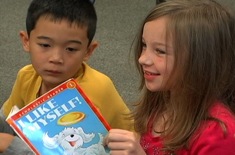This is my most cherished time of the day. Gathered with students on the floor, I am sitting just above them on a stool so I can feel closer to them, closer to their learning. Some days I am lucky and we have several times together on the carpet with read aloud magic. Reading aloud to children is by far my favorite part of the day. The academic field is leveled, all children shine, we make memories together. Together we go on adventures, think about characters, learn new information, create mental images in our own minds from the author details page after page.
“When a teacher reads aloud, it is a bonding between the teacher, the children, the books, and the act of reading.” —Lester L. Laminack
Read Alouds to Teach Academic Skills
Reading aloud to children is part of the instructional framework in my school corporation. We maintain that children learn from books across the curriculum and firmly believe children should have the experience of a read aloud every day. Our curriculum maps are created with units and books to stand as examples of our teaching points aligned to our state standards.
When it’s read aloud for the purpose of a teaching point, a book has an important job, and as the reader, I am communicating the teaching point—what students will learn. Sitting with a book for the read aloud before reading to the class, I think about how I want to use the book. I think about how to introduce the book before reading, where in the text I can pause to share my thinking to tie back to my teaching point, and how I want to end the book with a discussion that may be heavily supported or, if it is a skill we have been working on already, how I can engage student thinking with open-ended questions.
| Before Reading |
|
| During Reading |
|
| After Reading |
|
“Reading aloud and talking about what we’re reading sharpens children’s brains. It helps develop their ability to concentrate at length, to solve problems logically, and to express themselves more easily and clearly.” —Mem Fox
Read Alouds to Build Community
At the beginning of the year, building community through reading aloud to students is a focus of building a classroom to learn together. Continuing to read aloud each day continues this work. As we explore character interactions, we can relate to our struggles on the playground or classroom. We have used Kevin Henkes character Lilly several times in thinking about how to treat others, how to deal with disappointment, and how to be a good friend.
Titles to Continue Building Community for Primary Students
| Book | Community-Building Opportunities |
| Lilly’s Big Day
By Kevin Henkes |
Working through disappointment
Turning disappointment into friendship |
| David’s Drawings
Cathryn Falwell, illustrator |
Making friends
Working with classmates |
| Jamaica’s Blue Marker
By Juanita Havill |
Working through peer conflict
Friendship Sharing materials |
| Two Eggs, Please
By Sarah Weeks |
Accepting differences |
Read Aloud Books to Enjoy
Reading aloud to children for the joy of reading is one of my most treasured times. I don’t enter into the book with a teaching point tied to standards. I don’t have sticky notes all over the book. I don’t have a 10-minute slot to read and discuss the book so I can move to the next lesson. I read to enjoy the words the author has written and the pictures the illustrator has created.
I take my time, lingering on pages that I find interesting. As a class, we ask questions, go back to look at pages that were especially interesting, and add the author to our shopping list to see if we can find more of their books to add to our classroom library.
These times of enjoyment have already been successful, as evidenced by students asking what else we are reading today. The reading for pure enjoyment often happens at the end of the day when somehow we have finished all the lessons I planned and have just a few minutes left before the chaos of dismissal. Students have started bringing books from home as they have noticed books about what we have studied together in their home libraries. We have been able to revisit rhyming, digraphs, adjectives, and favorite authors with the books children bring from home to read.
“Reading should not be presented to children as a chore or duty. It should be offered to them as a precious gift.” —Kate DiCamillo
Maybe I especially enjoy this time together after reading to students on Zoom, recording videos of read alouds, and reading while we were spread as far apart as possible for a few years. Maybe it is a grateful heart that feels the appreciation for being gathered together, on the carpet with a book, to create a magical experience. As I write my lesson plans for the next unit, I hold each book and imagine the magic it will bring to the classroom and children. I get excited for the way each face looks as I read, eager for what will happen next. What magical read aloud do you have planned for your classroom tomorrow?



